Young Canadians are burning out at work, and the unchecked stress is contributing to a national mental health epidemic which costs the country more than $200B annually. Businesses have the opportunity—and imperative—to address this crisis by creating workplace cultures that prioritize mental wellbeing as a key performance driver, with embedded systems which proactively enable their employees to thrive.
Executive Summary
A quarter of all Canadians reported symptoms of mental health disorder in 2021, five million reported needing help for their mental health, and more than a third (35%) say they are burned out.
This crisis is disproportionately impacting young people. About 40% of Canadian workers aged 18 to 24 years are at a mental health “breaking point.” By the time they reach age 40, half will have experienced some form of mental illness.
Work is the number one source of stress for Canadians. But while most organizations care greatly about the health and wellbeing of their employees, many have been slow to recognize the extent of the crisis. A lack of strategy, a lack of support and stigma in discussing mental health have created workplace cultures where young people and their managers feel discouraged from presenting these issues.
But research by Boston Consulting Group shows that work is worth fixing. Our study finds that investing in mental health and wellbeing can create a virtuous cycle, delivering massive returns for Canadians, Canadian businesses and the economy as a whole. Through interviews, surveys and focus groups, we learned that:
- Healthier workplaces attract key talent: With unemployment rates at historical lows, Canada is increasingly reliant on younger workers. But attracting them requires changing organizational cultures. Two times as many Millennials and Gen Z workers as Baby Boomers say they want a workplace culture that prioritizes mental health and wellbeing, which means that the organizations that lead in these dimensions will have the upper hand in attracting top talent.
- Engaged workers are significantly more productive: Across Canada, workers with low mental wellbeing miss an average of five days of work each year and do the bare minimum on 37 other days. Companies that take measures to support employee wellbeing have seen their productivity improve by an average of 13%.
- Greater productivity leads to greater national prosperity: An average 13% bump in productivity rates would have a significant and positive impact on the country’s economic growth—lifting gross domestic product from $108,000 per employee today to $122,000 and lifting average profit per employee for Canadian businesses from $21,000 to $24,000.
Workplace wellbeing drives growth—but organizations will need to change their practices and cultures to unleash it. Top-performing businesses we’ve talked to have a shared goal: to become the organization that everyone wants to join. These are the steps to begin that journey.
- Make mental health and wellbeing a strategic business priority: For workplace wellbeing to materially improve, leaders must approach the topic in the same way they do any major competitive opportunity—by setting a vision, defining objectives, and creating a business plan. Senior leaders should be visibly and actively involved, and the planning team should also include visible minorities and members of the LGBTQ+ community.
- Develop Generative Leaders: Through coaching, classes and simulations, managers can learn effective ways to provide constructive feedback and ensure that all workers, especially younger ones, feel seen, heard, and valued. As part of that effort, leaders should also make individualized action plans with specific, observable commitments that they share with their peers and their teams. Public commitments help to ensure leaders feel personally accountable to model the behavior that we want to see more broadly in the organization.
- Build employee resilience: Resilience training should start at the very beginning of an employee’s tenure, since research shows that work habits become engrained in the first five years of one’s career. One of the most powerful ways to share learning is through storytelling—and creating opportunities for leaders and managers to share moments where they struggled and how they worked through those challenges. High-performing organizations will also invest in self-directed resources that employees can turn to at their own pace and schedule. These can include mindfulness apps, physical spaces where employees can disconnect from work, health classes and activity-based programs.
- Provide structured support: Making crucial interventions easily discoverable is essential. Creating websites or apps that house available resources in a single, easy-to-navigate “pane of glass” can help improve awareness and use of existing workplace programs. Having external career counselors that young workers can lean on and a network of outside medical services that employees can access is also important. Finally, organizations need to create policy support that can help managers and HR understand how to have productive conversations with employees. This guidance can help them navigate grey areas and understand when external resources may be most helpful.
Now is the time to act. Changing workplace cultures is a journey—but it is one that organizations must begin today. BCG is committed to making this same journey. We believe that wellbeing can open a wellspring of growth, improving quality of life for Canadians, increasing the productivity and competitiveness of Canadian businesses, and helping to attract and retain the next generation of Canadian talent.
We developed this report in hopes of sparking dialog and look forward to continuing our discussion with you.
Introduction
Young Canadians are burning out at work, and the unchecked stress is contributing to a national mental health epidemic.
A quarter of all Canadians reported they suffered from some form of mental illness in 2021, and five million said they needed help to manage those needs, making mental illness the leading cause of disability in the country.
Young people are disproportionately impacted. New to the workplace and rocked by years of pandemic-related dislocations, as many as 40% of workers between the ages of 18 and 24 say they are at a mental health “breaking point.” At current rates, nearly one in two Canadians will experience mental illness by the time they are 40. However, a lack of organizational focus and stigma in discussing mental health have kept these issues largely closeted and unaddressed.
Apart from the staggering human toll, declining mental health also has a significant economic impact . Research by Boston Consulting Group finds that the direct and indirect costs across Canada exceed $200 billion annually.
While work may be a key source of stress, it may also be the source of Canada’s recovery. BCG analysis shows that changing workplace cultures and practices to foster wellbeing can open a wellspring of growth, improving quality of life for Canadians, increasing the productivity and competitiveness of Canadian businesses, and helping to attract and retain the next generation of Canadian talent.
This paper looks at where workplace health is breaking down and what organizations can do to turn wellbeing into a wellspring of growth.
Canada Has a Mental Health Crisis
In late 2022, BCG surveyed more than 1,300 young Canadian workers and conducted more than 30 interviews, talking to employees, managers, leaders and field experts about how their workplaces contributed to their mental wellbeing.
What we learned was troubling. Each year, 20% of Canadians experience some form of mental health challenge. The pandemic has been an exacerbating factor, but the number of Canadians who say they are struggling with mental health has been growing even before the COVID-19 crisis, rising by more than 13% annually since 2016.
Work is a leading driver of declining wellbeing. Over 25% of Canadians report that work is the main source of stress for them, and 35% report being burned out.
Young people are especially vulnerable. In 2022, 50% of young professionals reported needing help for an emotional or mental problem. One reason is the pandemic, which disrupted normal processes for relationship-building and learning. Another is a lack of attention to helping newer recruits forge meaningful connections when they begin a new job. Absent practices that enable relationship building, meaning and purpose during onboarding, younger employees can feel isolated and adrift. About 20% of new entrants into the workforce report that transitioning into the workforce had a negative effect on their mental wellbeing. A third issue is regressive perceptions about Gen Z—that this generation “needs to be coddled” and “lacks ambition.” These negative biases remain persistent despite the fact that data consistently disproves them, and they make workplaces a more significant cause of stress for younger workers.
Black and Indigenous Canadians also face particular stressors: 55% of Black workers say they do not feel safe from workplace discrimination and 40% of Indigenous employees said they have been victims of bias as a result of their identity.
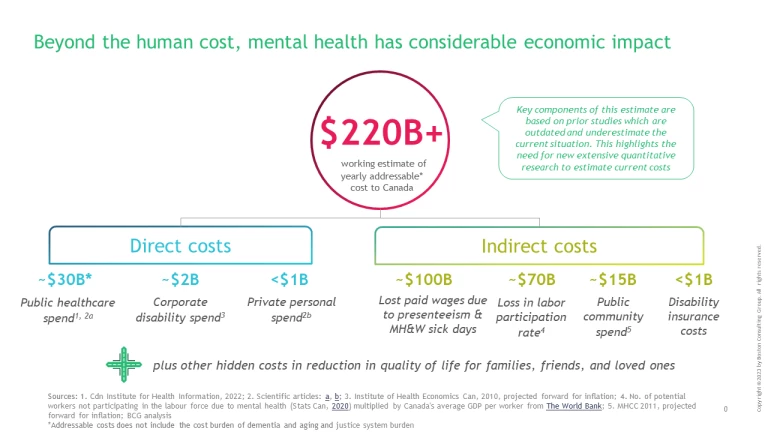
The total economic cost of addressing mental health and disability exceeds $220 billion annually. The direct costs, including public sector spend amounts accounts for nearly 10% of total public health spend or $32 billion overall. Indirect costs, including worker downtime and presenteeism, is estimated at $190 billion, plus other hidden costs in reduction of quality of life for family, friends and loved ones.
Fortunately, there are ways to mitigate this crisis, and Canadian businesses can take the lead in doing so.
Workplace Wellbeing Is a Growth Driver
Our research shows that investing in mental health and wellbeing can create a virtuous cycle, delivering massive returns for Canadians, Canadian businesses and the economy as a whole.
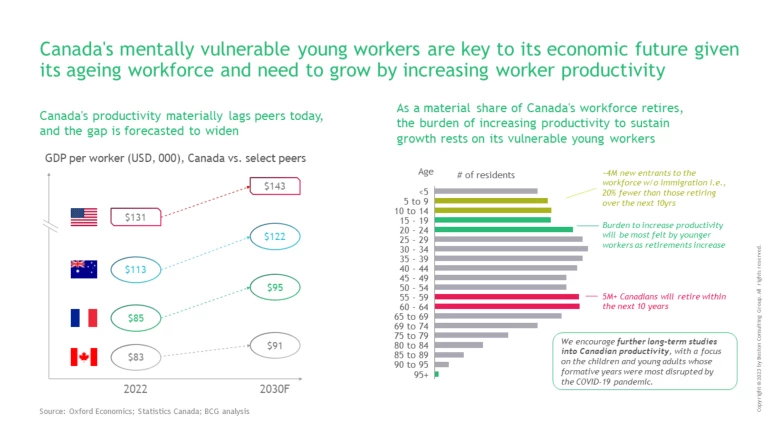
Here are some of the ways in which better workplace health delivers powerful ROI.
- Better retention and development of critical talent: With unemployment rates at historical lows, Canada is increasingly reliant on younger workers, and a talent shortage is already impacting a third of Canadian businesses. (See Exhibit 2) To attract the younger workers they need to replace retiring Baby Boomers, Canadian businesses have to change not only their recruiting methods—but also their organizational ones. Wellbeing has become a key selection criteria. Two times as many Millennials and Gen Z workers as Baby Boomers say they want a workplace culture that prioritizes mental health and wellbeing.
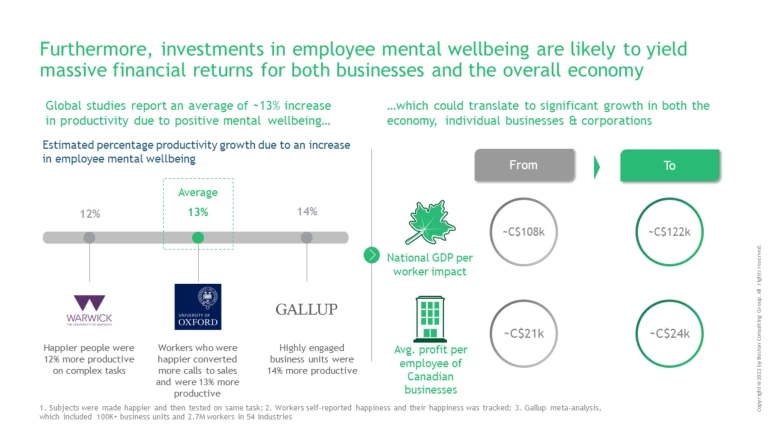
- Improved productivity: Wellbeing is highly correlated with productivity. Across Canada, workers with low mental wellbeing miss an average of five days of work each year and do the bare minimum on 37 other days. With Canada’s productivity already lagging the US, at roughly US$83,000 per worker in Canada versus $130,000 in the US, Canada cannot afford to ignore this issue. Encouragingly, companies that take measures to support employee wellbeing have seen their productivity improve by an average of 13%. (See Exhibit 3)
- Improved national prosperity: In economic terms, an average 13% bump in productivity rates would have a significant and positive impact on the country’s economic growth—lifting gross domestic product from $108,000 per employee today to $122,000. It could also increase average profit per employee for Canadian businesses from $21,000 to $24,000.
For Canada to reap these benefits, however, leaders need to understand the factors that are contributing to lower wellbeing at work.
Why Are Workplaces So Stressful?
Most organizations want to create vibrant and inclusive workplace cultures where individuals can thrive. Most also recognize the very real issues concerning burnout and the long-term strain many employees have been operating under since the pandemic began.
But the traditional business model has kept work and life largely separate, and matters of mental health further removed still. This orientation creates a culture that discourages workers from discussing stress. And that’s especially so for younger workers, who are taking their cues from those around them.
Through surveys, focus groups and interviews, BCG identified four factors contributing to lower mental health and wellbeing in the workplace.
- Health and wellbeing are seen as secondary to financial performance: While most organizations care about their employees, incentive structures and corporate planning have traditionally focused on financial performance. Matters of health and wellbeing are often seen as “soft” issues and less strategically significant than the “hard” realities of financial performance. Beyond a basic awareness that a healthy workplace is a happy one, there’s generally low awareness of broader strategic and competitive implications of high rates of burnout and stress and organizational performance; and relatively few organizations set near-term incentives and objectives with respect to wellbeing performance
These attitudes inform workplace culture, leading to perceptions that executives prioritize bottom-line health at the expense of overall employee wellbeing. An operations supervisor at an-commerce retailer said, “I want to prioritise the wellbeing of my employees. But what counts towards my promotion are sales and margin figures. If my people are able to deliver results, then all is well and good.” - Managers don’t know how to talk about mental health or if they even should: One of the most common barriers to accessing mental health and wellbeing support is discomfort in sharing the need for it. Managers often have little guidance on how to talk about mental health concerns with their reports and may feel these topics are beyond their “wheelhouse.”
And while organizations may track mental health and wellbeing measures, the findings are often confined to leadership. As a result, mental health can feel like a hidden issue, and managers—some of whom may also be struggling—may have little sense of the state of wellbeing in their workplace. The principal of an Ontario high school said, “I don’t receive any metrics or KPIs. We’re lucky if we get professional development from the central team even once a calendar year.”
The lack of transparency can further the view that mental health and wellbeing is not a priority. Few employees—especially younger ones—will want to stick their necks out on sensitive topics that might suggest a lack of fitness for their work, and without the encouragement of their managers, most don’t. A former intern at a large Canadian bank said, “I am never going to tell my employer that I am anxious or worried because they might perceive me as someone who can’t handle pressure well.” - Little awareness that mental health and fitness is a business skill: Few would argue that the ability to spring back from adversity is helpful, but in many businesses, this trait is viewed as innate when, in fact, it’s a learned quality. Social conditioning and training on how to deal effectively with setbacks are crucial to cultivating the growth mindset associated with mental resilience. Yet, our research found that 61% of employees do not receive coaching on how to handle job stress and 65% lack access to programs to prevent burnout.
Younger workers are most in need of such education, since they have had less time in their careers and less practice dealing with job-related challenges. And while many companies sponsor workplace and employee health programs, these initiatives are often folded into larger enterprise-wide efforts, such as diversity, equity and inclusion. Support functions are often tasked with owning these programs. But that can reinforce the notion that mental health and wellbeing concerns are secondary to the core business and give surveys and related training the feel of a performative, check-the-box exercise.
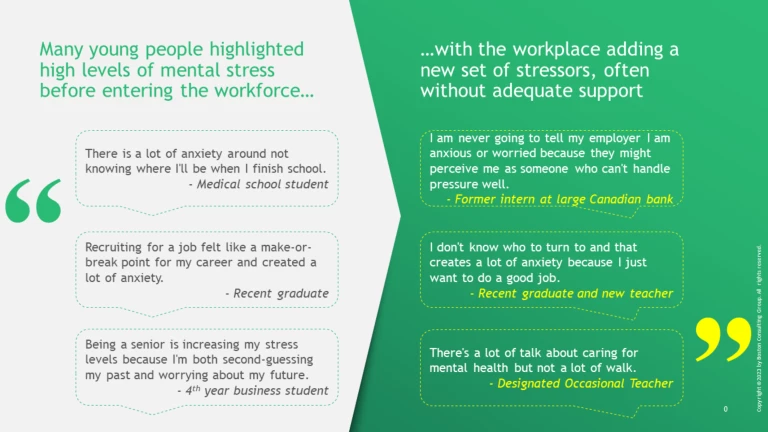
- Inadequate support systems: Our survey reveals significant demand for mental health and wellbeing services: 44% of employee respondents said they sought these supports in 2022. But a lack of clarity on what resources are available and dissatisfaction with the quality provided are common themes. 80% of those surveyed said they had trouble accessing mental health resources, and 50% were disappointed with quality received. A recent graduate and new teacher said, “I don’t know who to turn to and that creates a lot of anxiety because I just want to do a good job.”
Affordability of care is another worry, as is the lack of time to properly receive it. One young teacher told us, “Anything that is self-directed or an educational program often feels like an additional step someone has to take to seek out. It feels like it’s making me do more work, when the workload is what’s stressing me out.” Even when effective in-house resources are available, adoption can still be low, owing to the perceived stigma attached to them.
These challenges are complex. However, our research shows they are also addressable and can create a virtuous cycle that advances personal, professional and business growth—a win for Canadians and Canadian businesses.
Become the Organization Everyone Wants to Join
Taking the lead on mental health and wellbeing can give organizations competitive advantage—making them more attractive to key talent, and enabling significantly higher retention and productivity.
These are the steps companies need to take to begin that journey.
- Make mental health and wellbeing a strategic business priority: For workplace wellbeing to materially improve, leaders must approach the topic in the same way they do any major competitive opportunity—by setting a vision, defining objectives, and creating a business plan. To recruit and retain the young workers that Canadian businesses need for their future success will require a thorough rethink of career planning and development. Young talent is no less ambitious than their older peers, but many are not content to climb a predefined “corporate ladder.” Instead, they are looking for careers that will enable and empower them to use their distinct skillsets, shaping roles and responsibilities that make best use of their talent in ways that benefit the organization and its customers.
In developing the strategy, senior leaders should be visibly and actively involved, from helping to set direction to communicating the formal rollout, and the planning team should also include diverse voices to ensure that strategy reflects the particular needs and context of visible minorities and members of the LGBTQ+ community.
Having defined the strategy, top-performing companies give it teeth, creating KPIs that track progress and embedding accountability for achieving certain objectives into management reviews. Both employee-tracked data, such as from surveys and pulse checks, and system-tracked data, such as changes in short-term disability claims, attrition rates and vacation day patterns are essential to getting a complete view.
Done well, the results can be extraordinary. Bell created a holistic mental health strategy called “Let’s Talk” to address a spike in short-term disability claims related to declining mental wellbeing. Since launch, the strategy has helped to reduce short-term disability claims related to mental health by 20% and reoccurrence rates by 50%. For every dollar that Bell invested in workplace mental health programs, they earned $4.10. - Develop Generative Leaders: Generative leadership is a humanistic approach that yields highly motivated teams and creates a culture of psychological safety. This leadership model emphasizes open and fact-based communication, authentic connection, and shared learning and accountability.
Click here
for more information on generative leadership.
Through coaching, classes and simulations, managers can learn effective ways to motivate employees, provide constructive feedback and ensure that all workers, especially younger ones, feel seen, heard and valued. Leaders should also make individualized action plans with specific, observable commitments that they share with their peers and / or their teams. Public commitments help to ensure leaders feel personally accountable to model the behaviour that we want to see more broadly in the organization. At Google, for instance, managers who earn top feedback from their reports become mentors to other managers, creating a cascading effect. Those managers whose results are less positive receive extensive coaching and support.
Work practices can also be generative. Leading organizations increasingly deploy agile, project-based teams. This structure not only boosts productivity, it forges connection and creates a sense of shared mission and purpose—attributes that are particular valuable to younger employees.
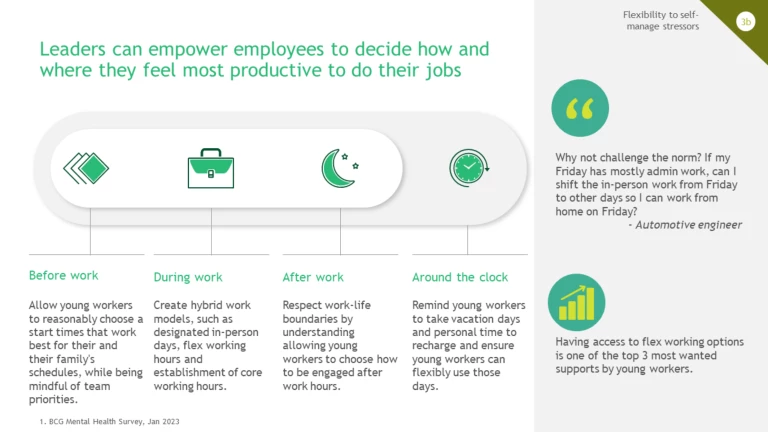
- Build employee resilience: Leaders should invest in structures that enable employees to self-manage around stressors. These can include self-directed tools such as mindfulness apps that workers can access at their convenience. It can also include on-premise resources such as physical spaces where employees can disconnect from work. Volunteer days, physical health classes and activity-based programs are other ways that companies and organizations can make space for younger workers to connect with co-workers and managers.
In addition, employers can support their employees to build their own mental fitness. The ability to overcome setbacks in professional life is a muscle that can be trained and built, like many other professional skillsets. One of the best ways to encourage this type of reflection is for leaders to share their personal stories of setbacks they faced, how they worked through the tougher periods in their career, and who they relied on for support – normalizing bumps along the way. To ease burnout at BCG, for example, each case team sits down to align on working norms and devise troubleshooting strategies at the start of any new project. These meetings, led by a facilitator, allow team-members to voice needs and brainstorm solutions, so they can continue.
We encourage resilience training to start at the very beginning of an employee’s tenure—during onboarding, since this period is particularly stressful for younger workers who are taking their first professional career steps. Our research shows that many workplace habits become engrained in the first five years of one’s career, so learning successful strategies to manage work-life issues early on can pay long-term dividends. - Provide access to structured support: Making crucial interventions easily discoverable is key. Young workers are likely to look to digital tools first. Creating websites or apps that house available resources in a single, easy-to-navigate “pane of glass” can help improve awareness and use of existing workplace programs. For example, Sobeys launched a public website that acts as a one-stop-shop for all mental health and wellbeing resources, including career counselling and guidance on how to access psychologists through the group benefits plan.
It’s crucial also to connect workers to high-quality professional resources. Young workers may want to keep certain discussions out of the workplace—both mental health and career related. Leaders can destigmatize such engagement by communicating the value that can be gained, and enabling confidential access, and providing protected time off for employees that seek. In line with Canadian Psychological Association guidance, organizations should provide coverage of at least $3,500 annually.
Finally, organizations need to create policy supports that can help managers and HR understand how to have productive conversations with employees. This guidance can help them navigate grey areas and understand when external resources may be most helpful.
Wellbeing doesn’t just happen. It’s a byproduct of cultural change. Canadian companies can play a meaningful role in alleviating the mental health challenges affecting the nation’s workers. The future is in our hands. Let’s get to work.
Acknowledgements
The authors would like to thank the following advisers and colleagues for their valuable contributions to the development of this article: Joseph Sexsmith, Bill Howatt, Josh Hellyer, Eric Windeler, Tanya Halsall, Nina Abdelmessih, Charlotte MacDonald, Alexandre Torres, Zubby Achara, Lauryn Murphy, Colan Wang and Heather Lau.









